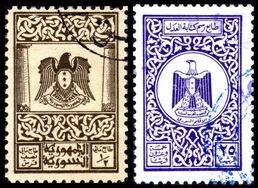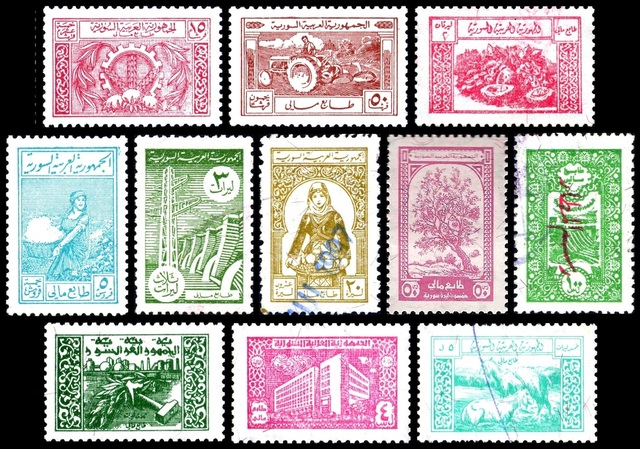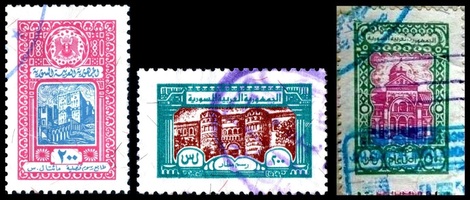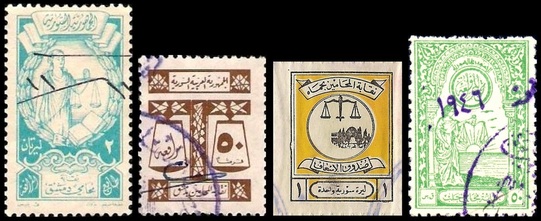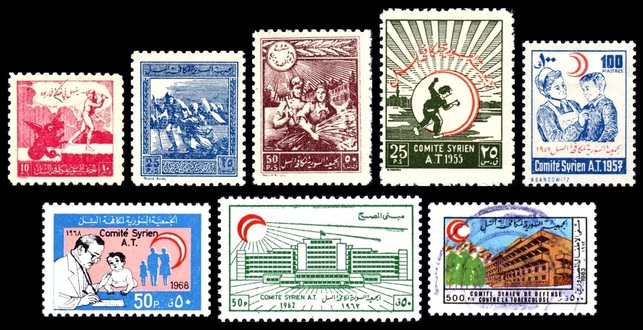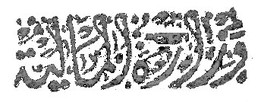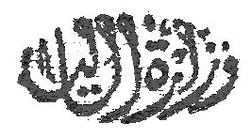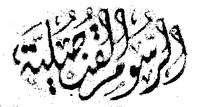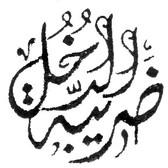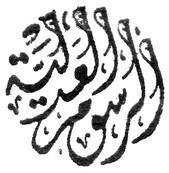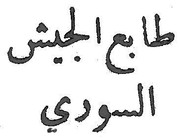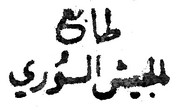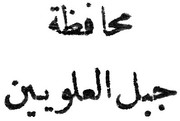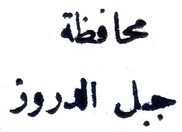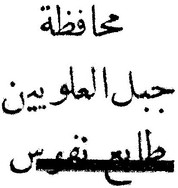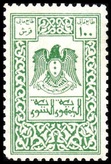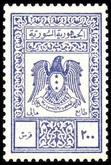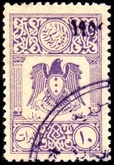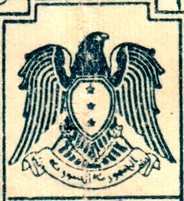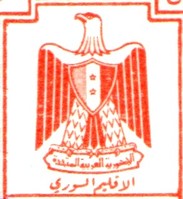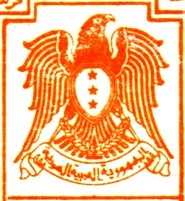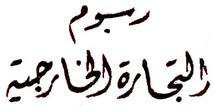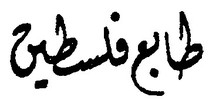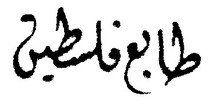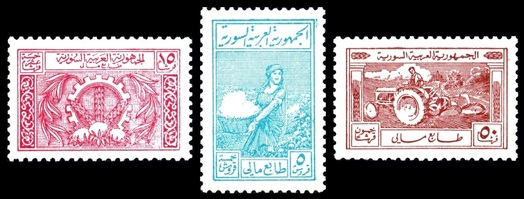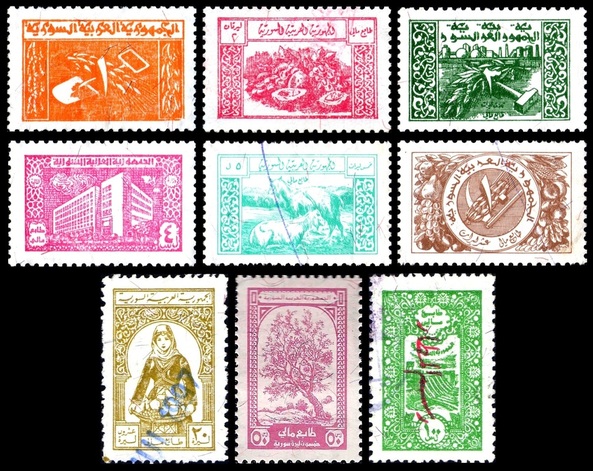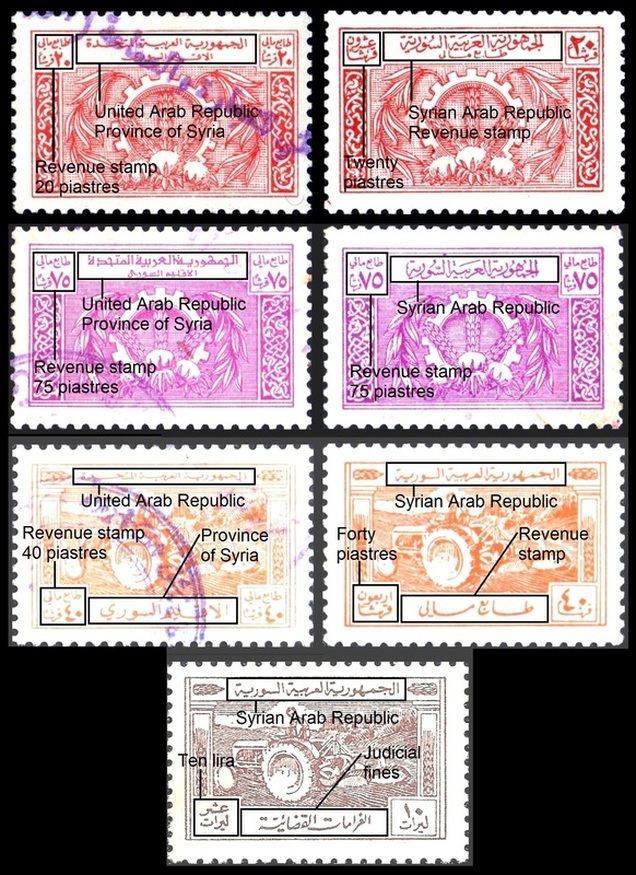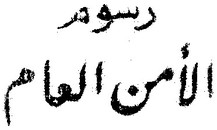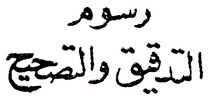Syria: An illustrated key to the different types used since 1939
This page is provided as an aid to identifying Syrian revenue stamps from Indepdence to the present day. All stamps illustrated here can be found in the Syria chapter of the catalogue, which consists of two pages - the main listing and Syndicates and Charities.
This illustrated key page is arranged as follows:
1. The basic stamp designs
2. The Harvester-Monument series (1930s-40s)
3. The Coat of Arms series (1949- )
4. The Agro-Industry series (1960s- )
This illustrated key page is arranged as follows:
1. The basic stamp designs
- Mainstream revenues (further details of these follow in sections 2 to 4)
- Syndicates and Charities
2. The Harvester-Monument series (1930s-40s)
- Overprints
3. The Coat of Arms series (1949- )
- Arms
- Inscriptions
- Overprints
4. The Agro-Industry series (1960s- )
- Inscriptions
- Overprints
1. The basic stamp designs
Mainstream revenues
All stamps illustrated here are listed on the Syria main page
Mainstream revenues
All stamps illustrated here are listed on the Syria main page
|
_Coat of Arms series
This series comprises a wide range of different frames, inscriptions and overprints, but can be readily identified by the common feature of having the Syrian Coat of Arms in the centre, consisting of either the hawk facing right or the eagle facing left (see section 3 below for full details) |
_These three pictorial designs are for Consular, Airport Tax and General Security respectively
For full details see under catalogue numbers C281/3, A91 and G355 on Syria main page
For full details see under catalogue numbers C281/3, A91 and G355 on Syria main page
Syndicates and Charities
All stamps illustrated here are listed on the Syria (Syndicates and Charities) page
All stamps illustrated here are listed on the Syria (Syndicates and Charities) page
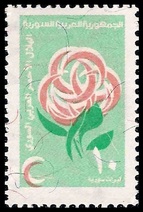
_
The stamp illustrated at left is a Charity label
for the Syrian Arab Red Crescent.
Stamps of this type are listed as TC10/11 on the
Syria (Syndicates and Charities) page
The stamp illustrated at left is a Charity label
for the Syrian Arab Red Crescent.
Stamps of this type are listed as TC10/11 on the
Syria (Syndicates and Charities) page
_2. The Harvester-Monument series (1930s-40s)
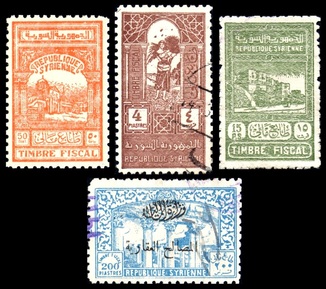
_The Harvester-Monument series (1930s-40s) is based on four different designs, all of which are inscribed République Syrienne Timbre fiscal (= Republic of Syria Revenue Stamp) in
French as well as Arabic. As unoverprinted stamps they are listed in
the catalogue as Revenue R401/434 (Harvester) and R441/459
(Monuments). They were also issued with a wide range of overprints for
various purposes.
Overprints
The 22 different recorded overprints are shown below. The two varieties of Ministry of Finance overprint are shown first, then the remainder grouped by appearance: oval types, then straight-line overprints of one, two and three lines of Arabic. Note: further overprints in Western letters only (S.A. and H.D.) are not illustrated here, but are listed under Sanjak of Alexandretta (Hatay) at the foot of the Syria main page.
a) Ministry of Finance control overprints
Both the overprints shown below read Ministry of Finance, and seem to have been used as a control or security measure. These were used either on their own (see R461/480a under main Revenue listing) or in combination with other overprints (see under listing for the other overprint)
Overprints
The 22 different recorded overprints are shown below. The two varieties of Ministry of Finance overprint are shown first, then the remainder grouped by appearance: oval types, then straight-line overprints of one, two and three lines of Arabic. Note: further overprints in Western letters only (S.A. and H.D.) are not illustrated here, but are listed under Sanjak of Alexandretta (Hatay) at the foot of the Syria main page.
a) Ministry of Finance control overprints
Both the overprints shown below read Ministry of Finance, and seem to have been used as a control or security measure. These were used either on their own (see R461/480a under main Revenue listing) or in combination with other overprints (see under listing for the other overprint)
_
b) Oval or circular types
b) Oval or circular types
c) Straight-line types
|
|
One line of Arabic
Two lines of Arabic
Three lines of Arabic
|
|
3. The Coat of Arms series (1949- )
This section covers the various types of Syrian revenue adhesive which featured the Syrian coat of arms surrounded by Arabic inscriptions. The initial issue was produced in 1949 for general revenue duty, using five different frame types to denote tiers of value - frame A being used for the lowest values of a series, B for the next few values, and so on.
This section covers the various types of Syrian revenue adhesive which featured the Syrian coat of arms surrounded by Arabic inscriptions. The initial issue was produced in 1949 for general revenue duty, using five different frame types to denote tiers of value - frame A being used for the lowest values of a series, B for the next few values, and so on.
Note: Duston mistakenly treats the different frames as different issues, and lists a number of stamps which in my view cannot exist, eg Revenue 10p in frames A and C. These are footnoted in my listing.
The original Revenue issue was later overprinted to provide adhesives for other appropriations, then in due course the five original frames were reissued with modified inscriptions.
Arms
Three different versions of the Syrian coat of arms are used on these issues. The original revenue series featured the Hawk of Qureish, holding a banner with the wording (in Arabic) Republic of Syria. This was the national coat of arms until 1958, when Syria joined forces with Egypt to form the United Arab Republic. At this time a new coat of arms was adopted featuring the Eagle of Saladin and a revised banner reading United Arab Republic. This Eagle-type coat of arms is known on just one series of revenue stamps (the 1960-61 Notarial issue), presumably reflecting the relatively short life of the UAR. These stamps are additionally inscribed Province of Syria below the banner to indicate that they were valid only in the Syrian half of the UAR and not in Egypt, which continued to issue its own revenue stamps.
The third version of the coat of arms is very similar to the original version but the banner has been amended to Syrian Arab Republic, which was the official name adopted by Syria after the union with Egypt was dissolved in 1961. This final type also has the hawk slightly redrawn.
Inscriptions
Each different appropriation has its own particular inscription in the main panel. This is the box containing two lines of script towards the foot of frame types A and C, the long rectangular panel at the top of types B and D, and the circular disk at the top of type E.
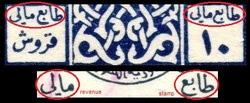
'Revenue Stamp' inscribed on types A to C (top) or D and E
All stamps of the original Revenue issue are inscribed Republic of Syria in the main panel. The words Revenue Stamp are inscribed within the value tablets on frame types A to C, or to the lower left and right of the coat of arms on types D and E.
The late types of adhesive have the appropriation name inscribed in the main panel, with no additional inscription (apart from the value) within the value tablets or beside the coat of arms. The different types of main panel inscription are shown in the table below.
|
Frame type
|
|
Overprints
The original Revenue series was overprinted to produce adhesives for other appropriations. The fifteen different recorded overprints are shown below.
|
|

Consular (top), Judicial (middle), Land (bottom)
Most of the overprints are fairly easy to distinguish, but three types are very similar to one another: the Consular, the Judicial and the second type of Land Fee overprints. It seems that Duston may have conflated the first two types in his listing, since he does not mention the Judicial overprint and his drawing of the Consular has features of both. He illustrates the Land Fee overprint (on a later issue) but treats it as another form of Consular overprint.
The left-hand portion of each overprint is enlarged here as an aid to identification. Reading from right to left, they spell out qnsliyah (consular), qdaiyah (judicial) and ‘qariyah (land).
The principal differences are:
1. Horizontal stroke at left (Arabic y) is joined to the upright stroke in Consular but not in the other two.
2. The Judicial overprint has an additional dot (to convert Arabic s to d) above the central whorl.
3. The Consular overprint has an additional notch (Arabic n) to the left of the Arabic letter q, which the Judicial overprint does not have.
4. The Land overprint has a distinctive downward curl (Arabic r) towards the left-hand end of the overprint, which the other two types do not have.
4. The Agro-Industry series (1960s- )
The Agro-Industry series is a catch-all term for three different groups of designs which have been in use from 1960 to the present day:
The Agro-Industry series is a catch-all term for three different groups of designs which have been in use from 1960 to the present day:
First group (1960- )
- Values from 5p to 1l
- Designs of agricultural images: farm produce (two variants on this design), harvester, tractor and plough
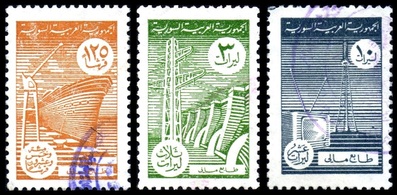
Agro-Industry series - second group
__Second group (1964- )
- Values from 125p to 10l
- Designs of industrial images: crane and ship, pylon and dam, TV and transmitter mast
- All values except the 125p and 250p were replaced with designs of the third group
__Third group (1976- )
Inscriptions
- Values from 1l to 100l
- Designs of industrial and agricultural images: spade and ear of corn (1l), farm produce (2l), hammer and processing plant (3l), Finance Ministry building (4l), horse and goat (5l), scythe and fruit (10l), woman with basket of fruit (20l), orange tree (50l), Tabqa Dam (100l)
Inscriptions
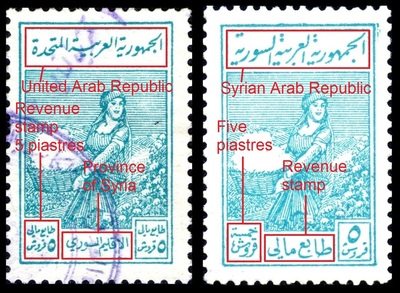
Harvester design used for 5p and 10p values
_
The first group of designs are inscribed either United Arab Republic Province of Syria (from the original 1960 issue) or Syrian Arab Republic (used from 1964 onwards). The tractor type was also issued for judicial purposes with the inscription Judicial Fines at foot instead of Revenue Stamp. These different inscriptions are illustrated here.
The first group of designs are inscribed either United Arab Republic Province of Syria (from the original 1960 issue) or Syrian Arab Republic (used from 1964 onwards). The tractor type was also issued for judicial purposes with the inscription Judicial Fines at foot instead of Revenue Stamp. These different inscriptions are illustrated here.
_All stamps of the second and third groups are known only with the inscription Syrian Arab Republic Revenue Stamp.
Overprints
Ten different overprints have so far been recorded on the Agro-Industry stamps, including two types each for Airport Tax and Land Fees. All these types are enlarged here as an aid to identification. (The images for the first types of Airport Tax and Land Fees are from Duston.)
Overprints
Ten different overprints have so far been recorded on the Agro-Industry stamps, including two types each for Airport Tax and Land Fees. All these types are enlarged here as an aid to identification. (The images for the first types of Airport Tax and Land Fees are from Duston.)
|
|

